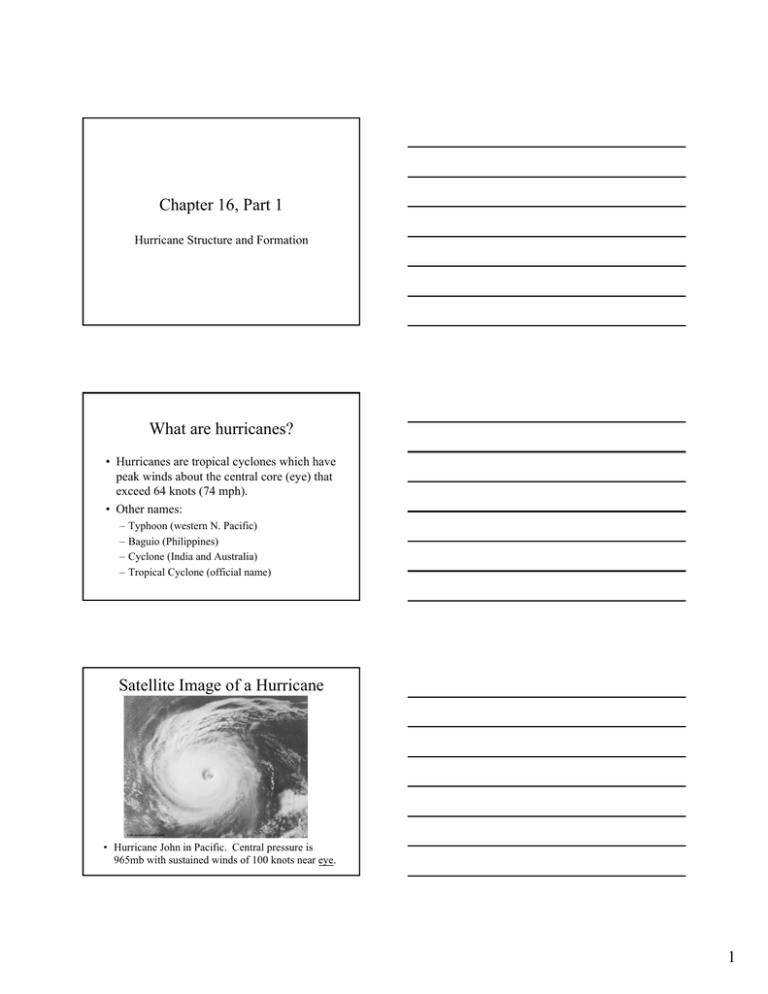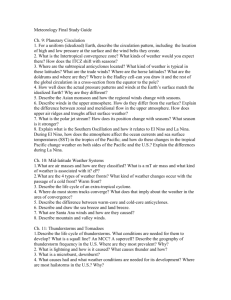Chapter 16, Part 1 What are hurricanes?
advertisement

Chapter 16, Part 1 Hurricane Structure and Formation What are hurricanes? • Hurricanes are tropical cyclones which have peak winds about the central core (eye) that exceed 64 knots (74 mph). • Other names: – – – – Typhoon (western N. Pacific) Baguio (Philippines) Cyclone (India and Australia) Tropical Cyclone (official name) Satellite Image of a Hurricane • Hurricane John in Pacific. Central pressure is 965mb with sustained winds of 100 knots near eye. 1 Structure of a Hurricane • Eye – winds light, clouds mainly broken, surface air pressure is very low (here 965mb); diameter = 20-50 km typically • Clouds align into spiraling bands (spiral rain bands) • Surface winds increase in speed as they blow counterclockwise and inward toward the center. • Wind and precipitation is most intense at the eye wall. 1. Weather in a Hurricane • • • • Going from west to east: Sky becomes overcast. Pressure drops slowly, then more rapidly. Winds blow from North or Northwest with increasing speed. • High winds generate huge waves (10m) and are accompanied by heavy rain showers. 2. Weather in a Hurricane • As we move into the eye, the air temperature rises, winds slacken, rainfall ceases, and the sky brightens (fewer clouds). The barometer is now at its lowest. • Enter eastern side of eye wall. Heavy rain and strong southerly winds. • Moving away from the eye wall, pressure rises, winds diminish, rain diminishes, … as the process reverses. 2 1. Model of a Hurricane • Organized mass of thunderstorms. • Moist tropical air flows in to hurricane’s center. • Near eye, air rises & condenses into thunderstorms. 2. Model of a Hurricane • Near top of thunderstorms, dryer air flows outward from the center (actually flows clockwise). • At the storm’s edge, this air begins to sink and warm, inducing clear skies. 3. Model of a Hurricane • In the thunderstorms of the eye wall, the air warms leading to higher pressures aloft and downflow in eye. • Subsiding air warms by compression accounting for the warm air and absence of thunderstorms in the eye. 3 1. Hurricane Formation • Hurricanes form over tropical waters where – Winds are light – Humidity high in a deep layer – Surface water temperature is warm (80oF). • Occurs in topical N. Atlantic and N. Pacific in summer and early fall. • Hurricane season normally runs from June through November. 2. Hurricane Formation • In the tropics (between 23.5oN and 23.5oS) the noon sun is always high in sky. • Coupled with high humidity this frequently leads to development of cumulus clouds and thunderstorms. • In some cases the thunderstorms may become organized and form a hurricane. • For that one needs convergence. 3. Hurricane Formation • Sources of convergence: • Intertropical convergence zone (ITCZ) – an area of low pressure may develop along a wave in the ITCZ. • Topical waves – converging and diverging region in easterly winds in the tropics (common for Atlantic hurricanes). • Front that moves into the tropics. 4 Tropical Wave Streamlines showing wind flow. • Thunderstorms form in converging region. • Typical wavelength 2500km and speed 10-20 knots. 4. Hurricane Formation • The converging air begins to spin counterclockwise because of the Coriolis force. • Can not happen right at the equator where Coriolis force is zero. • Two thirds of all hurricanes form between 10o and 20o latitude. 5. Hurricane Formation • Need upper-level winds to diverge and leave more quickly than surface air is converging (upper level air support). • Trade wind inversion near 20o is caused by sinking due to subtropical high (prevents). • Hurricanes do not form when upper level winds are strong and can disrupt the organization of the storm (occurs over Atlantic more frequently in El Nino event). 5 1. Organized Convection Theory • Suppose air aloft is unstable, e.g. colder. • Large clouds are generated. 2. Organized Convection Theory • Release of latent heat warms the upper level air creating an upper level high. • Upper-level winds move outward away from the high enhancing surface low. 3. Organized Convection Theory • Chain reaction (feedback mechanism): – – – – Rising air releases more heat Increases surface low & upper level high Stronger surface winds More waves and friction • Controlling factors are the temperature of the water and the release of latent heat. • When storm is full of thunderstorms, it has used up all available energy. 6 Heat Engine Theory • Heat engine - heat is taken in at a high temperature, converted into work, and then ejected at a lower temperature. • For hurricanes source of heat is sensible heat at surface and latent heat of condensation. • Heat taken in at ocean surface, converted to kinetic energy of wind motion, and lost at top due to radiation cooling. • Not clear at present which theory (or both) drives hurricanes. Stages of Hurricane Development • Tropical Disturbance – thunderstorms with only slight wind circulation • Tropical Depression – winds increase to between 20 and 34 knots. Several closed isobars appear. • Tropical Storm – winds are between 35 and 64 knots. • Hurricane – winds exceed 64 knots (74 mph). Visible Satellite Image 1. 2. 3. 4. Tropical Storm Hurricane Tropical Depression Tropical Disturbance 1 2 3 4 7 Comparison of Hurricanes & Middle Latitude Cyclones Hurricanes Middle Latitude Cyclones Counterclockwise air flow Counterclockwise air flow Surface low Surface low Energy from warm water & latent heat of condensation. Weakens with height Energy from horizontal temperature contrasts. Winds strengthen with height Eye Rising air in center Warm air from surface up Cold upper level L to west Relationship with Other Storms • Some polar lows that develop over (relatively warm) polar waters in the winter may have – – – – a symmetrical band of thunderstorms a cloud-free eye a warmer core of low pressure strong winds near the center. • Some northeasters may have a cloud-free eye, very strong winds, and a warm inner core. Summary • Hurricanes are tropical cyclones composed of organized thunderstorms with winds about the eye exceeding 64 knots (74 mph). • They derive their energy from warm tropical water and latent heat of condensation. • They form in a region of surface convergence and upper level divergence. 8






